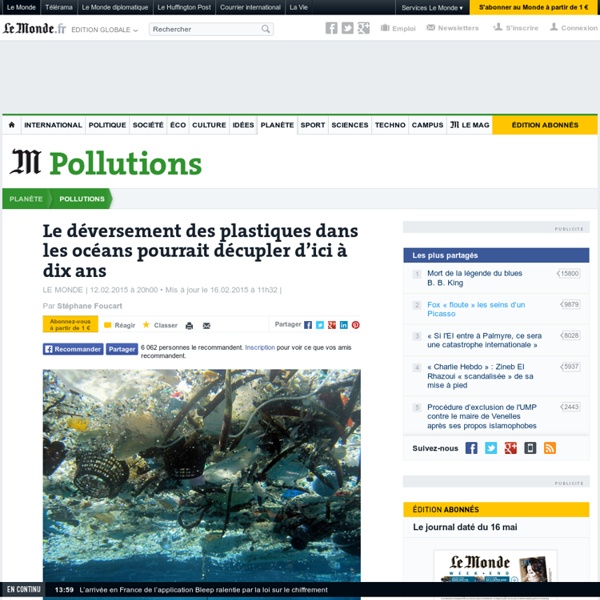There’s a scary amount of plastic in the ocean. Here’s who put it there
This story was reproduced here as part of the Climate Desk collaboration. Marine scientists have long known that plastic pollution in the ocean is a huge problem. The most visible sign of it is the Great Pacific Garbage Patch, an accumulation of waste (actually spanning several distinct patches) floating in the ocean. It’s at least twice the size of Texas and can be seen from space. This pollution has an incalculably lethal effect on everything from plankton to whales. So just how much plastic is there? If we want to crack down on all that plastic, knowing where it all comes from could be as important as knowing how much there is. The last step is to estimate how much of the mismanaged coastal plastic waste actually washes into the sea. The chart below shows the worst offenders, in terms of total plastic pollution in the ocean in 2010, using data from the study. That’s right: China alone dumped nearly 5 billion pounds of plastic waste into the ocean in 2010.
Des huîtres nourries aux micro-plastiques
Une étude française montre l'impact de la pollution plastique sur le développement et la reproduction des huîtres. Une alerte alors que les tonnes de plastiques déversées en mer ne cessent de croître. C'est un biologiste marin de l'Ifremer à Brest, Arnaud Huvet qui a publié cette étude dans les comptes rendus de l'académie américaine des sciences. Au final, elles produisaient moins d'ovules, leurs spermatozoïdes étaient moins mobiles, elles étaient moins grosses Le taux de fécondation par rapport à des huitres moins polluées était inférieur de 41%. En 2050, il y aura plus de plastique que de poissons dans la mer Lors du sommet de Davos fin janvier, l'ancienne navigatrice Ellen Mac Arthur, aujourd'hui à la tête d'une fondation de défense de l'environnement, estimait même que d'ici 2050, le poids des plastiques dans la mer serait supérieur à celui des poissons.
Plastic waste responsible for nearly 92% life-threatening cases in marine life | Customs Today Newspaper
MEXICO: According to a new study thousands of individual animals from hundreds of marine species including every kind of sea turtle and around half of marine mammals have encountered plastic, glass, and other garbage in the ocean. Often the encounters are fatal. In some cases they may be helping push some beleaguered species towards extinction in the wild. Those are some of the findings in the most comprehensive look at the effects of debris on marine wildlife since 1997. Co-authors Sarah Gall and Richard Thompson, marine biologists at Plymouth University in the United Kingdom, looked in 340 different publications for reports about animal encounters with marine trash. They found that 693 species of marine animals had some sort of interaction with human-made debris, with 17 percent of them listed with some degree of vulnerability to extinction on the International Union for Conservation of Nature red list.
definition
Sailing Seas of Plastic - Interactive Data Visualisation
About the Study M. Eriksen, L.C.M. Plastic pollution is ubiquitous throughout the marine environment, yet estimates of the global abundance and weight of floating plastics have lacked data, particularly from the Southern Hemisphere and remote regions. Using an oceanographic model of debris dispersal calibrated by our data, and correcting for wind-driven vertical mixing, we estimate a minimum of 5.25 trillion particles weighing 268,940 tons. Read the publication
micro plastique
Here’s all the plastic in the ocean, measured in whales
Let’s see how closely you know your marine doom-and-gloom: Just how much plastic can be found in the oceans? A) A lot. B) A whole helluva lot. C) Both A and B. D) All of the above. While those answers are all FINE, now we can get a little more specific thanks to a study by the 5 Gyres institute. This was actually less plastic than the researchers expected to find at the surface, but they suspect the missing plastic is likely being eaten by organisms, or otherwise mulched by the gyres, and sinking deeper into the oceans.
micro plastique 2
Europe’s plastic bag rule is a breath of fresh air
Plastic bags are the worst. They’re made of oil, they’re filling up the oceans, they’re showing up in sea turtles, they’re killing birds and plankton, too, and they’re even threatening human health, as plastic works its way up the food chain to the top predator: us. That’s why the European Union worked so hard on a new compromise aimed at cutting Europe’s throwaway plastic bag use by 80 percent over the next decade. E.U. governments unanimously approved the measure last Friday, reports Newsweek. Yes, that’s right. Political actors from states like Denmark, where folks use four lightweight plastic bags per year, on average, found a happy medium with the likes of Portugal, whose residents go through them at 100 times that rate, and all sides agreed to the deal because the ecological damage is too great to ignore. What to do about this oceanic mess? Celebrate the progress, but beware of complacency.
disturbing-infographic-shows-how-plastic-is-clogging-our-oceans
With an estimated 6.4 million tons of plastic getting dumped in the ocean annually, build-up has become a huge problem that merits serious attention. We have a serious plastic problem here on Earth. In less than a century, plastic has permeated every aspect of our lives, creating tremendous amounts of waste that does not degrade. Much of it ends up in the oceans – an estimated 6.4 millions tons annually – which wreaks havoc with marine wildlife. From entanglement to ingestion, sea animals are suffering as a result of our obsession with plastic and reluctance to switch to reusables. The following infographic is called “Spiraling Out of Control: Plastic Buildup in Our Oceans” and comes via CustomMade. © CustomMade (used with permission)



